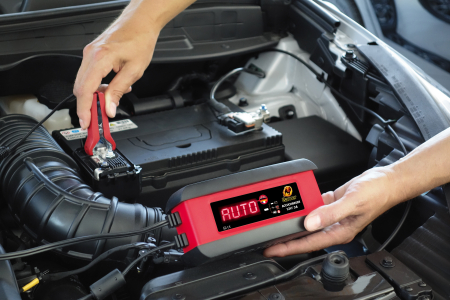2 BATTERY DEADLY SINS
THAT YOU SHOULD AVOID AT ALL COSTS!
Avoid these 2 "deadly sins" when handling a battery at all costs!
Overcharging and lack of gas discharge.

Consequences of overcharging
The picture shows an overcharged and extremely gassing car battery. What happened here? Charging and subsequently overcharging of an originally discharged start-stop car battery, of course unattended overnight, with a so-called workshop charger with W-characteristic (falling current with rising voltage = transformer characteristic).
The workshop charger only has a voltage limit, often only at approx. 15.5V! The voltage (in volts) rises continuously during the charging process, while the charging current (in amperes) keeps falling. The charge must always be stopped manually in time to prevent overcharging, overheating, prevent excessive gassing of the battery and water loss In other words, constant monitoring of the state of charge is strongly recommended with these chargers!
The battery also lacks a degassing hose for correct and safe oxyhydrogen vent!

Banner Accucharger – for professional battery charging and charge retention. Simple, fully automatic, safe and fast.
Banner tip: With a charger from the Accucharger series (fully automatic, voltage-regulated with charging voltage limitation 14.7V), overcharging of the battery and extreme gassing are avoided! Banner chargers allow conventional starter batteries and start-stop-batteries to be charged without disconnecting them from the vehicle's electrical system and are particularly suitable for cars, commercial vehicles, classic cars and boats. They also offer professional, simple, fully automatic, fast and safe battery charging and charge maintenance.
In the HOW-TO video you can find all the information on the subject of "Charging a battery" - just click on it!
Fully automatic chargers (charging voltage limited to 14.8 V) are well suited for charging the battery installed in a vehicle. If your charger has an automatic mode with voltages >14.8 V, the battery must be disconnected from the on-board electronics or removed from the vehicle altogether. For Banner, this applies, for example, to the Accucharger 6A Recovery and 10A Recovery chargers – both with a maximum charging voltage of 15.8V for charging deeply discharged batteries. In the worst case, the installed control units could be destroyed by overvoltage, the resulting damage would be enormous.
Please pay attention to the type of charger. Valuable tips on charging the vehicle can be found in most of the operating instructions issued by the vehicle manufacturer or the charger manufacturer.
All values quoted refer to a room temperature of +25 °C. Caution: Temperature compensation in case of deviation.
PS: Gassing is good for electrolyte circulation, counteracts possible acid stratification, but means some water loss! As a rule of thumb, the maximum charging voltage must not exceed 14.8V (constant voltage), the gassing voltage is approx. 14.6V - this specification applies to all calcium batteries (Ca)!
More articles on this topic

